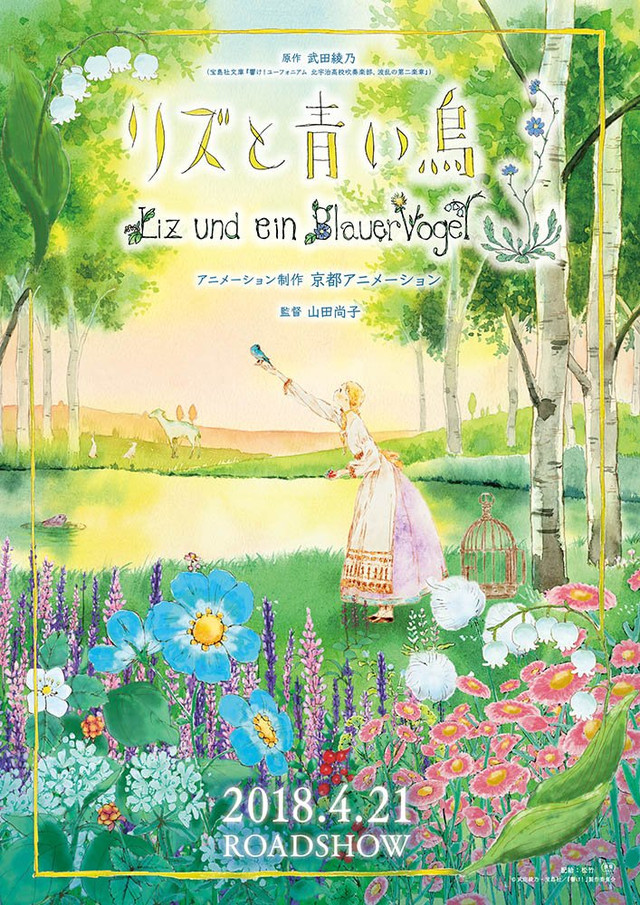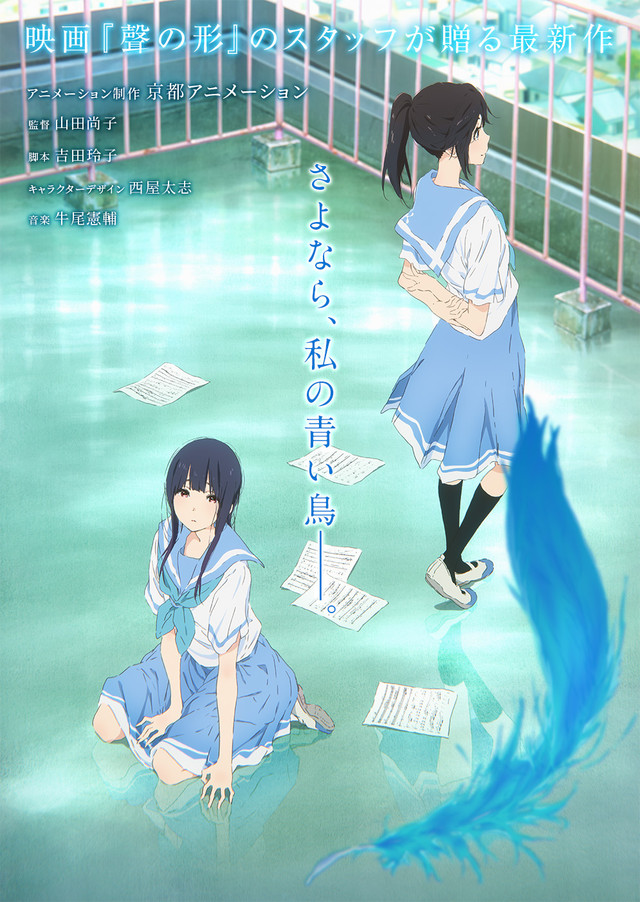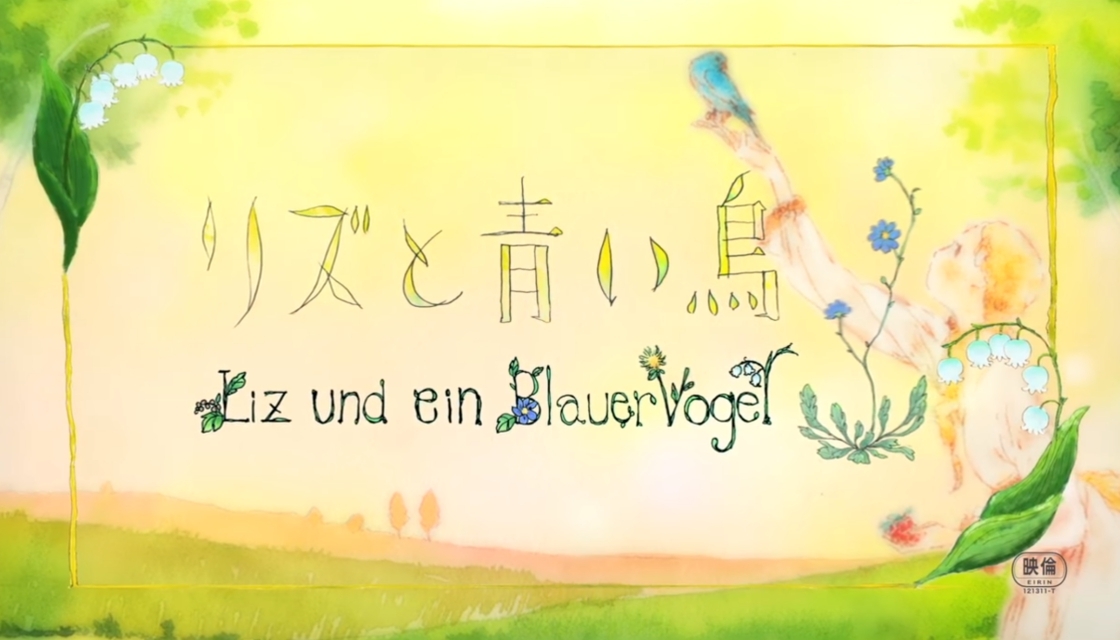It’s been three years since Sound! Euphonium (Hibike! Euphonium) aired, but thanks to the magic of anime, no one has aged aside from the folks behind the scenes. Coming off the wonderfully executed A Silent Voice (Koe no Katachi), director Naoko Yamada and composer Kensuke Ushio team up once again to fashion a new ballad. The US premiere and panel at Anime Expo gave a lucky few a musical treat.
The film hardly misses a beat when introducing, or reintroducing for some, Mizore and Nozomi. Mizore and Nozomi are both members of the school orchestra and play the oboe and flute respectively. Both are to perform a piece for the national competition, but while they are a pair, the struggles of their changing relationship have bled into their increasingly discordant practices. Both also happen to be a fan favorite couple, and they will not be competing with Kumiko and Reina this time. For Yamada, this film also represents a chance to continue the story of Mizore and Nozomi and bring it to a proper conclusion without the pacing problems that dogged the second season of Sound! Euphonium.
When we meet Mizore, she is a painfully shy girl (or co-dependent for those with harsher sensibilities) who joined the school orchestra to follow Nozomi. Mizore hardly interacts with the rest of the band, and the early attempts of her juniors and fellow woodwinds to socialize fall flat. In contrast, Nozomi is the far more sociable leader of her flute section and leads group practices. Despite the personality differences, Nozomi and Mizore get along pretty well, and they are chosen for the piece Liz und ein Blauer Vogel (Liz and the Blue Bird) as part of the competition program. Unfortunately for the school conductor, things aren't coming together as well as he had hoped even though he has talented musicians in Mizore and Nozomi.
We first see Mizore’s reasons for struggling mightily despite being talented. When the time came for her to submit a school/career intentions worksheet, Mizore left it blank because she didn’t know what she wanted. Being uncertain about her future school is only part of the larger issue of Mizore’s dread of losing Nozomi. Mizore likens her situation to Liz in the piece Liz and the Blue Bird. Like Liz, Mizore has no human friends in the beginning, and she leads a lonely existence. At least until Nozomi comes into her life just like the Blue Bird that magically becomes human to provide companionship to Liz. While a straight play of Mizore’s ending paralleling Liz’s would be predictable and droll, Yamada is content to string us along until the twist.
The story of Liz in the piece is just as integral to the film as Mizore’s. Both of the titular characters know the story well with Nozomi having a personal copy and Mizore borrowing one from the school library. Nozomi loves the story but despises the ending because she would prefer to have a happy one. In the story of the musical piece, things go swimmingly as Liz and the Blue Bird enjoy a strong closeness, and Liz wants the Blue Bird to stay with her forever. While the Blue Bird does provide Liz with joy, it becomes progressively clear that the Blue Bird is paying a price to be human. Whether it is longingly looking up at the sky or sneaking out a night, it slowly dawns upon Liz that things cannot continue as they are. As the story goes on, Liz frees the Blue Bird in the end, but while Mizore empathizes with Liz and her attachment, Mizore doesn’t believe she could ever let her Blue Bird, Nozomi, go.

©Ayano Takeda,TAKARAJIMASHA/Hibike Partners
Nozomi isn’t as carefree as she initially seems. In the beginning, Nozomi seems merely to be the object of Mizore’s affections, but we learn more and more about her as the film progresses. We are reminded about her misadventures during her previous years when she quit and abandoned Mizore in her exit. Nozomi is a talented flute player, but we later learn that she is not as perfect as Mizore would have us believe. While Nozomi projects an air of confidence, it starts falling apart once both Mizore and Nozomi get called in to see the counselors. It turns out that Mizore was not the only student to turn in a blank career intentions worksheet. Despite the similar start to a dreadful meeting, Mizore is encouraged to think about applying to a music conservatory away from town. Nozomi, however, is simply encouraged to think about a local school and reflect on what she wishes to do.
It is the gradual evolution of their relationship that drives the rest of the film towards the happy ending that we know is coming. While the end of high school is a well-worn trope, there is no fairytale ending for Nozomi and Mizore. Much like how college admissions can obliterate the dreams and aspirations of teenagers, Nozomi and Mizore have to calibrate their expectations in the face of disappointment. It’s not all sunshine and rainbows, but the resolution feels perfectly adult and implies a far more mature relationship going forward. If I had any complaints, it would be that Yamada seems perfectly content with being a shameless tease much like Nozomi. Japan has long had a tradition of muted lesbianism in manga and anime, but judging by the premiere’s strong audience reaction, I think it would be time to be blatantly clear that Mizore and Nozomi are much more than friends.

©Ayano Takeda,TAKARAJIMASHA/Hibike Partners
Despite the minor complaints, Yamada and Kyoto Animation have delivered a beautiful film that is bright and crisp. The parts where Liz and Blue Bird get screen time look as though a children's book had sprung to life with its use of watercolors. Mizore has few speaking lines despite being the lead, but thanks to the animation team, Yamada was more than able to make up for it with visual cues and body language. Composer Kensuke Ushio and his team’s efforts to bring credible music into the film are readily apparent. Not only do we come to associate Nozomi and Mizore with their respective instruments, they also took pains to use everyday sounds to convey a sense of place, space, and even emotion. Much like how Kyoto Animation had to rise to the challenge of speaking for the laconic Mizore, Ushio and his team were able to use music and sound to convey the unspoken.
Liz and the Blue Bird is the kind of film that doesn’t get much use out of the improvised screening room used at Anime Expo 2018. Fortunately, there are plans in place to bring Liz and the Blue Bird to theaters in November, but there has been no announcement of actual dates or screening locations. This may not be a grand cinematic achievement, but not every film needs to be Schindler’s List. Sometimes there is beauty and value in the comings and goings of the everyday.

